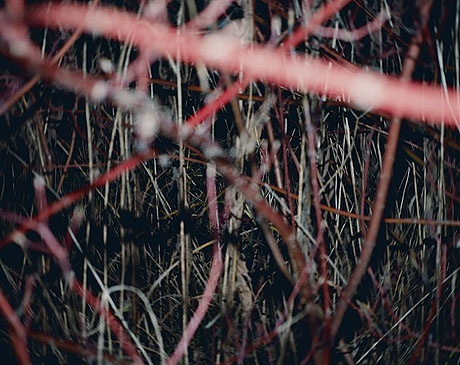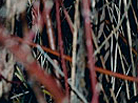replikantki (4) — język do lizania — Justyna Gruszczyk i Bianka Rolando

„Replikantki” to cykl wystaw w Małej Przestrzeni prezentujący twórczość młodych polskich artystek. Tytułowe określenie ma wpisany w siebie rewolucyjny potencjał, generowanie nieznanych wartości, odwracanie przeciwko systemowi, który je stworzył. Miarą prawdziwości przywołanych historii staje się niezgoda na sformatowanie do racjonalnych ram i sztywnych, logicznie uzasadnionych podziałów, potrzeba mocnego upodmiotowienia kobiety-autorki w strategiach lektury. Odkrywanie sensu tkwiącego w szczególe staje się bazą do stworzenia nowego języka, w którym artystki nie występują w roli outsiderów, ale znajdują miejsce dla mówienia o sobie, w pewnym przesunięciu do obowiązującego fallogocentrycznego porządku. Sięgając do intymnych doświadczeń zatracają się w tekstach, rozłożone w toksycznych wydzielinach własnej sieci.

„Replikantki” — intymne przekazy artystek (teksty, prace, idee) skumulowane w publikacji Książka została zaprojektowana jako dokumentacja cyklu wystaw, który odbywał się w Galerii Sztuki Współczesnej BWA w Katowicach w...

replikantki (3) — minimalne poprawki — Alicja Karska i Aleksandra Went Prace Aleksandry Went i Alicji Karskiej wydają się oporne w swojej prostocie, szczelnie zamknięte. Tak jak w przypadku snów, co do...

replikantki (2) — cieplarniane warunki — Natalia Bażowska, Kinga Bella, Magdalena Starska, Tatiana Wolska Drążenie autorskich wizji oprócz precyzyjnych narzędzi wymaga cierpliwości i uwagi, jeśli lektura jest przeprowadzana z biegu wytraca sens....

replikantki (1) — znieczulenie — Dorota Buczkowska „Lilith”, „Interror”, … Znieczulenie znosi świadomość, ból i odruchy obronne. Jako zabieg wynika z potrzeby utwardzania, ochrony przed zbyt intensywnymi doznaniami....

Joseph Beuys w jednej ze swoich legendarnych akcji szepce coś do ucha martwego zająca, którego nosi na rękach. Nie wiadomo co mówi. Zgodnie z tytułem tłumaczy mu obraz. Zwykle trudno przestać wsłuchiwać się w niezrozumiała mowę dopóki brzmi melodyjnie. W przyłączających się jedno do drugiego słowach zanika powoli to co miało zostać zakodowane. Doświadczenie rozrzedza się.
Justyna Gruszczyk i Bianka Rolando mają wiele do opowiedzenia. W bulimicznym odruchu wysysają szczegóły otaczającego świata. Zdając sobie sprawę, że takie pożywianie się rzeczywistością musi znaleźć ujście, snują przed zaśnięciem swoje własne baśnie na uspokojenie. Mówią je przede wszystkim do siebie. „Założę tylko dziecinny śliniaczek, bo mogę zacząć się ślinić od nadmiaru słów...”, pisze Bianka w „Białej księdze”. Jej polsko-włoskie pochodzenie wymuszało szybkie przekładanie jednego języka na drugi. Z takiej świadomości pułapek czających się w procesie tłumaczenia wynika jej fascynacja pograniczem mówienia: pomrukiem, mlaskaniem i śpiewem. Z tej pozycji rozbraja kolejne używane przez siebie media. Uważa na słowa, wie że od słodkich psują się zęby, a brzydkie trzeba wydrapywać.
Tym razem w galerii równolegle robi notatki i rysunki, zostawia na podłodze węgiel i sukienki zanurzone w miodzie. Wygląda jakby jej przygotowała do czegoś zostały przerwane, a histeryczne opowiadanie zawieszone w połowie zdania. Hiperaktywność Bianki daje wyobrażenie o skali nagromadzonej historii nie do wypowiedzenia. Schematy porządkujące jej język pozostają ukryte.
Justyna Gruszczyk jako mała dziewczynka nie chciała chodzić w miejsce, gdzie rosły maliny. Podobno w ich krzakach czaił się potwór, który miał miękkie i ciepłe futro. Na pewno był wielki. Justyna nie pamięta, ale chciałaby się go jeszcze przestraszyć. W swoich zapachowym pracach często sięga do momentu przesytu, barokowości, pełni na granicy przesytu i gnicia. Przywołuje historie, których bohaterowie marzą o tym, by czas się zatrzymał, i kiedy ich marzenie się ziszczają, najpierw są szczęśliwi – bez kontroli dorosłych mogą chodzić po sklepach i wyjadać cukierki za darmo. Potem jednak dopada ich przerażenie, że zostaną w zatrzymanym czasie na zawsze, i nikt ich nie uratuje. Dzieciństwo nie daje jej spokoju. W jednej z napisanych przez siebie baśni musi wracać do nie zamkniętego pokoju wewnątrz siebie wchodząc przez małe zagięcie skóry na pięcie. Bohaterka „... z olbrzymią prędkością zjeżdżała po kości piszczelowej, jak po zjeżdżalni. Odpoczywała chwilę na rzepce, i zjeżdżała dalej kością udową. Krętarz większy wyrzucał ją w górę jak skocznia. Spadała miękko na jajnik, skąd jajowodem szła do macicy, gdzie zazwyczaj robiła sobie krótką drzemkę na mięciutkich czerwonych poduchach. Szła dalej, łapiąc od wewnątrz mięśnie brzucha i wspinając się po nich, jak po skałkach. Potem przedostawała się na płuco, skąd widziała już drzwi. Ale otwarcie ich nie było proste, obok znajdował się potwór, który ich strzegł. Był czerwony, krwawy, z całej siły łomotał, stukał i trzaskał. Wabił się Serce. Królewna często zastanawiała się, co byłoby, gdyby ją zabił, i jak wyglądałaby na zewnątrz, gdyby umarła wewnątrz siebie. Zawsze jednak udawało jej się uciec – kiedy potwór spinał się do skoku, królewna zwinnym susem dopadała drzwi, znikając za nimi, zanim zdążył ją dosięgnąć. Tajemny pokój był za każdym razem inny. Znajdowała w nim kufry, latające dywany, stare rękopisy, suknie, maski, księgi i tysiące innych rzeczy”.
Klucz do tych często niebezpiecznych powrotów Justyna znajduje w wykorzystaniu zmysłu węchu. Podczas wciągania i wypuszczania powietrza zamieszkuje kolejne miejsca, buduje zaufanie do nich. Do Małej Przestrzeni przygotowuje ciemny pokój, z miękką podłogą, wypełniony intensywnym zwierzęcym zapachem. Z nostalgią odtwarza okoliczności, które towarzyszyły jej dziecięcym lękom.
Niedobór i urwany trop wyostrzają apetyt. Gruszczyk i Rolando zostawiają za sobą obierki, wylinki, sukienki, wydmuszki, rozmówki rozsypane we fragmentach. Zaborczy charakter ich instalacji wymaga od widza jednoznacznego sprzeciwu, inaczej zawłaszcza go i terroryzuje. Trzeba być ostrożnym albo przeciwnie dać się wciągnąć i grać na wyznaczonych przez artystki zasadach. Każde użycie języka, chociaż powiązane z nieuniknionym zabiegiem przyszpilenia i wyjałowienia, w końcu okazuje się dla mówiącego lecznicze.
Kuratorka: Marta Lisok
Fotorelacja z wernisażu do obejrzenia na portalu sztuka.pl




